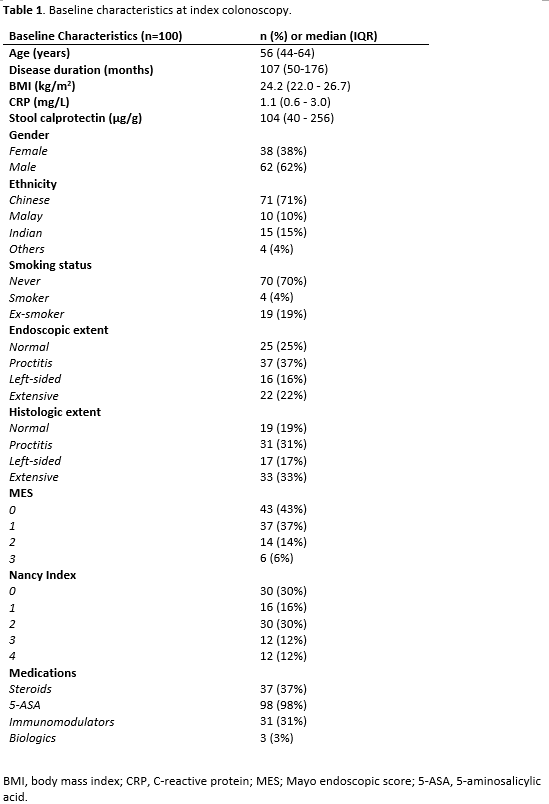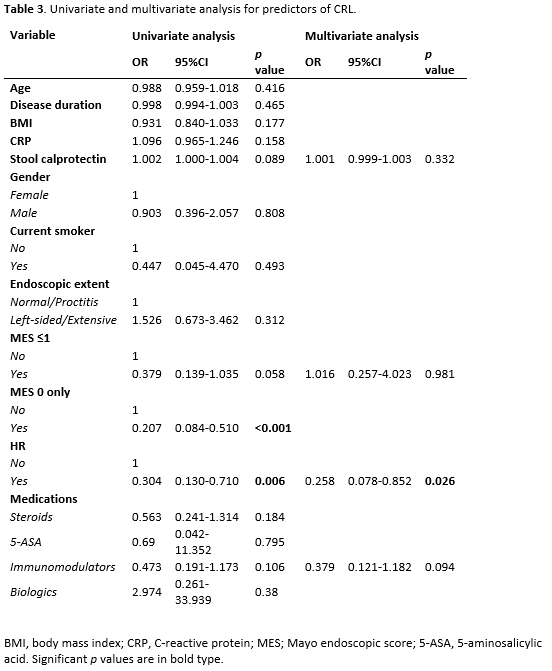P819 Histologic activity and clinical outcomes in Ulcerative Colitis
Liang, R.(1)*;Lin, H.(1);Lim, W.C.(1);
(1)Tan Tock Seng Hospital, Gastroenterology and Hepatology, Singapore, Singapore;
Background
Microscopic inflammation persisting in ulcerative colitis (UC) patients with endoscopic remission (ER) may be associated with a higher risk of clinical relapse (CRL). Growing evidence suggests histologic remission (HR) improves clinical outcomes. Data from Asian UC patients is lacking. We hypothesize that achieving HR is associated with better clinical outcomes in Asian UC patients.
Methods
We performed a single-centre retrospective cohort study of UC patients in clinical remission (CR) who had a follow-up (‘index’) colonoscopy and minimum one-year follow-up post-colonoscopy. CR was defined as Simple Clinical Colitis Activity Index (SCCAI) ≤2. ER was defined as Mayo Endoscopic Sub-Score (MES) ≤1 at index colonoscopy. HR was defined as Nancy Index ≤1 at index colonoscopy.
CRL was defined as either SCCAI>2 (sub-score >1 for stool frequency or rectal bleeding), medication escalation for active disease, hospitalisation for UC relapse or colectomy for refractory UC.
Kaplan-Meier survival analysis was performed to evaluate clinical relapse-free survival post-colonoscopy. Univariate and multivariate regression analyses were performed to assess predictors of CRL.
Results
169 consecutive UC patients who had undergone colonoscopy from 1 Jan 2000 to 30 Jul 2019 were assessed for eligibility. 100 patients were included with a median follow-up of 22 months. At index colonoscopy, 80 patients (80%) were in ER, with 20 patients having persistent endoscopic activity (Table 1). On follow-up, 41 patients (41%) experienced CRL, with 59 remaining in CR.
Of 80 patients in ER, 34 (42.5%) had persistent histologic activity (Nancy Index ≥2) and 29 (36.3%) relapsed during the follow-up period (Table 2). Amongst patients in CR and ER, those with HR had lower CRL rate (26.1% vs 50%, p=.028) and longer clinical relapse-free survival (mean 46.1 vs 31.5 months, p=.015) than those with persistent histologic activity (Figure 1).


On univariate and multivariate analysis of 100 patients in CR, HR was significantly associated with lower risk of CRL (Table 3).
Conclusion
Above and beyond CR and ER, achieving HR improves clinical outcomes in Asian UC patients. Further prospective studies evaluating the benefit of histologically guided therapeutic decisions are needed.


